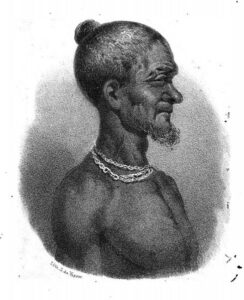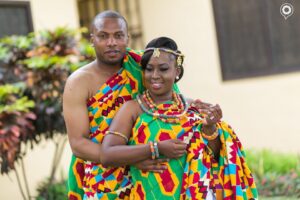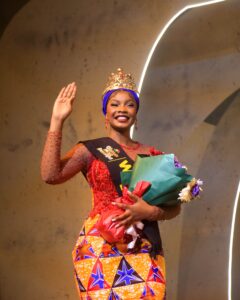
Source: ebay
In the Akan culture, the concept of time is linked to the sound of the bell (dɔn). Unlike the modern method of telling time through clocks and digital devices, the Akan people have traditionally relied on the sound of the “dɔn” to mark the passage of hours and significant moments throughout the day. This unique approach to time-telling is not just a practical measure but a reflection of the community’s rhythm and lifestyle that is deeply rooted in their traditions and daily practices. In this article, I will explore how bell (dɔn) functions as a timekeeper in Akan society and its cultural significance.
In Akan, both “adɔma” and “dɔn” refer to the bell. Despite tonal patterns and other phonological differences influencing the pronunciation across various Akan dialects, “dɔn” is the term most familiar to the layperson. Regardless of the term used, Akans have long utilized this sound device for time-telling, a practice deeply rooted in their history and culture.
The history of time-telling in the Akan culture is fascinating and rich with intriguing tales. It is believed that, in ancient times, the Akan people, and some other cultures of Ghana measured time using the length of a person’s shadow. The height of a person’s shadow, whether long or short, indicated a specific time of day.
As to how they told time during the deep evening and dawn remains a subject of wonder. The mystery of how our ancestors managed to measure time without the sun’s presence showcases their ingenuity and intimate understanding of their environment. Despite the challenges posed by the changing light conditions, our forefathers were able to maintain a structured sense of time that enabled them to live and work efficiently.
This historical approach to time-telling not only reflects the resourcefulness of the Akan people but also highlights the importance of time in their cultural and social organization. The ability to gauge time accurately allowed them to coordinate activities, rituals, and community events that fostered a harmonious society. The legacy of these time-telling practices continues to be a point of pride and cultural identity for the Akan people and to any other Ghanaian culture that used to practice.
There is a school of thought that believes the concept of time-telling in Akan culture is rooted in the role of the bell used by Christian missionaries when they arrived on the coast of the then Gold Coast in 1471. This perspective posits that the missionaries mounted metallic or wooden bell posts, ringing the bell to call members to gather for worship. The number of times the bell was rung represented the time of a particular moment.
For instance, when the bell was rung once, it was referred to in Akan as “dɔnkor,” meaning “one bell,” which signifies one o’clock. When it was rung twice, it was called “ndɔnebien” (n – plural marker + dɔn – bell + ebien – two), meaning two o’clock, and so on.
Till date, Akans cannot tell time without the mentioning of “dɔn” (bell). It can be seen in the following examples:
i. Abɔ ndɔnsia – It is six o’clock
ii. Abɔ ndɔndu – It is ten o’clock
iii. Nonum abɔ apa ho sima du – It is ten minutes past five o’clock
iv. Abɔ ndɔnum mpaamu – It is five thirty
v. Nonsia abɔ apa ho sima nson – It is seven minutes past six o’clock
(Data is in both Fante and Twi dialects of Akan)
The question now remains, “How was time told during the shadow time-telling era?”

During colonial times at the Castle, another fascinating method of time-telling emerged at twelve o’clock: the role of the cannon. According to a different school of thought, a cannon positioned at the forecourt of the castle, facing the sea, was fired precisely at noon to indicate twelve o’clock. This tradition has persisted in Akan culture, where twelve o’clock is still referred to as “prɛmtow ber,” meaning “cannon shooting time.”
Before noon, when it is eleven o’clock, Akans simply state the number eleven as “dubiako.” Same can be said of twelve o’clock, apart from using the concept of the cannon – duebien. This is the only instance where time is conveyed solely by its number in Akan tradition.
Overall, the following is how time is told in Akan considering only the hour mark:
Dɔnkor – One o’clock
Ndɔnebien – Two o’clock
Ndɔnebiasa – Three o’clock
Ndɔnan – Four o’clock
Ndɔnum – Five o’clock
Ndɔnsia – Six o’clock
Ndɔnsuon – Seven o’clock
Ndɔnwɔtwe – Eight o’clock
Ndɔnkron – Nine o’clock
Ndɔndu – Ten o’clock
Dubiako – Eleven o’clock
Duebien / prɛm atow – Twelve o’clock
Indeed, the role of the bell and, to some extent, the cannon cannot be underestimated in time-telling within the Akan setting. The bell, known as “dɔn” in various forms across Akan dialects, has long served as a fundamental device for marking the passage of time. Whether in calling communities to gather or indicating specific hours throughout the day, the sound of the bell resonates deeply in Akan cultural practices.







Ndɔn-num (abɔ) apa ho sima du Is NOT “five past ten”, It is, *Ten (minutes) past five (hours)*
Please, verify your writing with others who are also very knowledgeable in the subject; always ask, if in doubt, and question yourself at all times!
Thank you very much for this correction. We at Ghanalingo do appreciate.